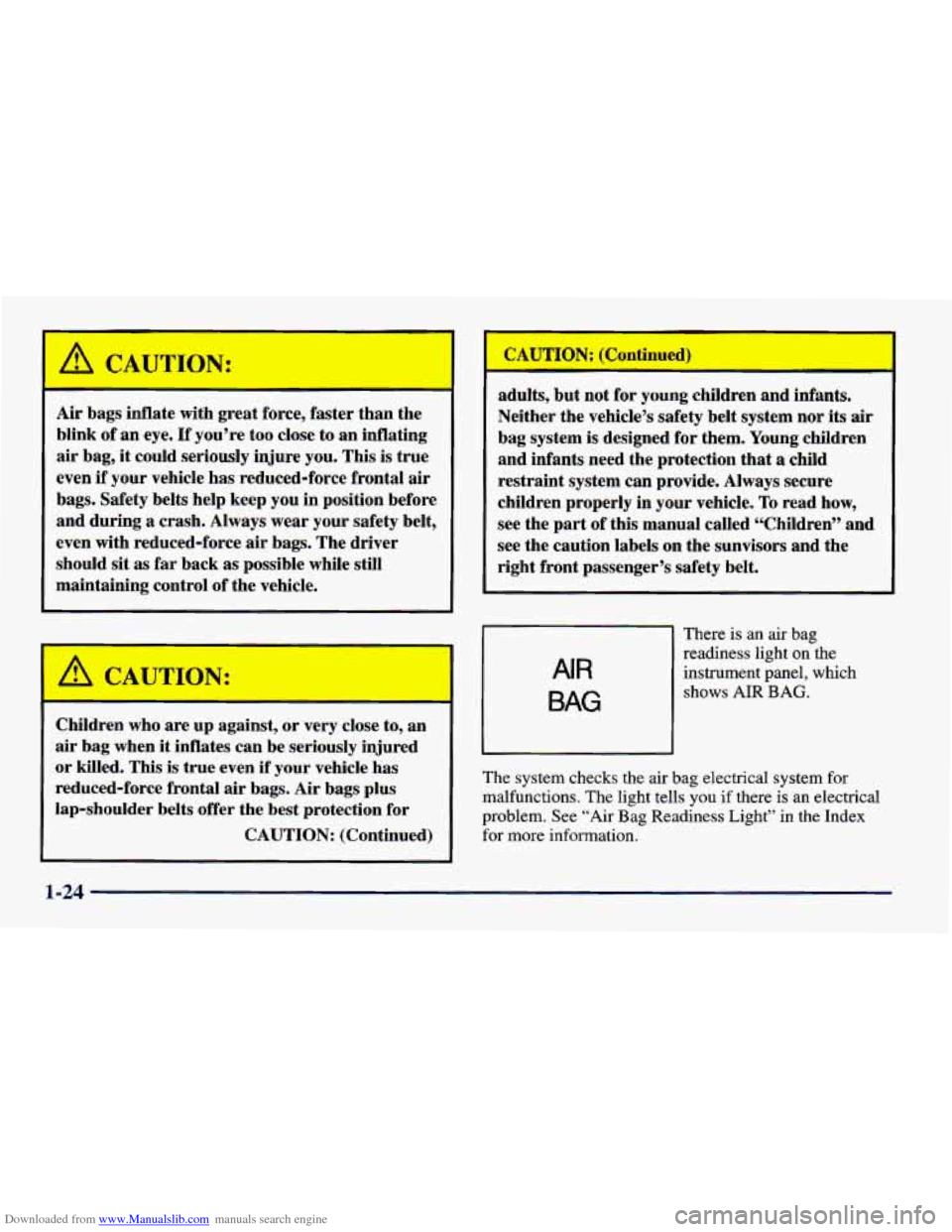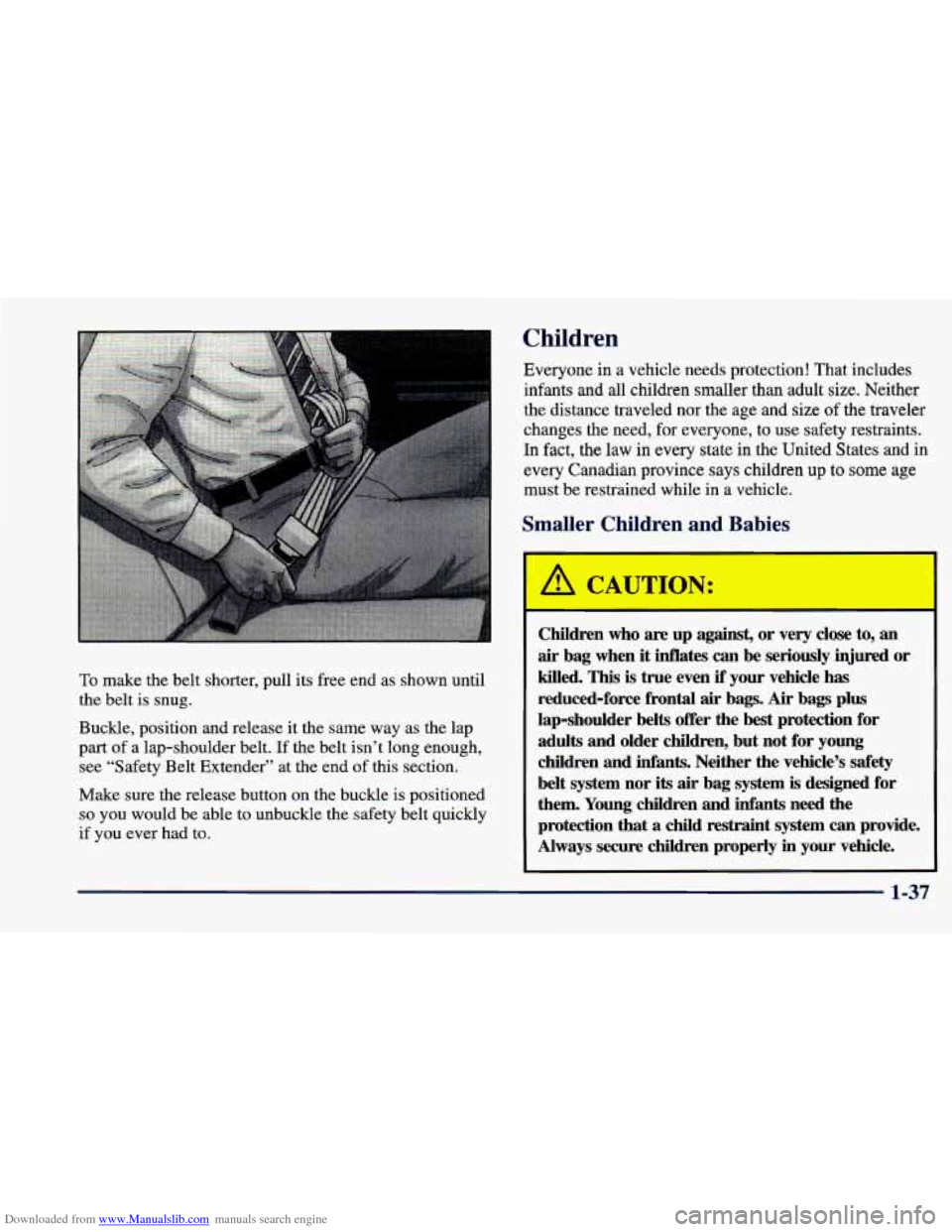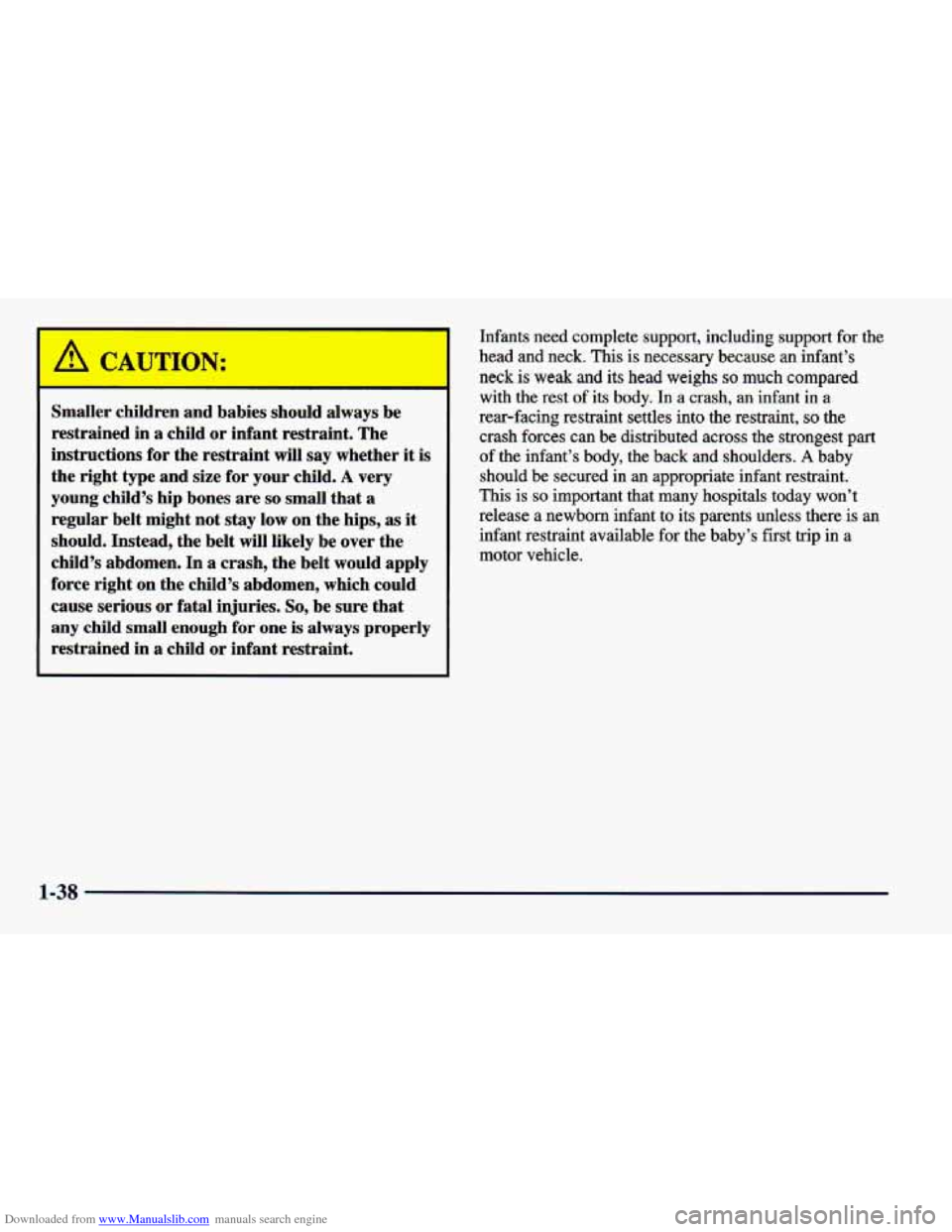Page 25 of 400
Downloaded from www.Manualslib.com manuals search engine Rear Seats
Folding the Rear Seat
I
To open the fold-down rear seat, pull forward on the
seat tab.
To close the seat, push the seatback up to its
original position.
Check to ensure the seatback is in its original position and securely latched by pulling forward
on the top
of the seatback. Move any obstructions in the trunk
compartment.
1-7
Page 33 of 400
Downloaded from www.Manualslib.com manuals search engine I
If the belt stops before it reaches the buckle, tilt
the latch plate and keep pulling until you can buckle
the belt.
Pull up
on the latch plate to make sure it is secure.
If the belt isn’t long enough, see “Safety Belt
Extender” at the end
of this section.
Make sure the release button on the buckle
is
positioned so you would be able to unbuckle the
safety belt quickly if you ever had to.
5. To make the lap part tight, pull down on the buckle
end
of the belt as you pull up on the shoulder belt.
1-15
Page 42 of 400

Downloaded from www.Manualslib.com manuals search engine I
Air bags inflate with great force, faster than the
blink of an eye.
If you’re too close to an inflating
air bag,
it could seriously injure you. This is true
even
if your vehicle has reduced-force frontal air
bags. Safety belts help keep you in position before
and during a crash. Always wear your safety belt,
even with reduced-force air bags. The driver
should sit
as far back as possible while still
maintaining control of the vehicle.
Children who are up against, or very close to, an
air bag when it inflates can be seriously injured
or killed. This is true even if your vehicle has
reduced-force frontal
air bags. Air bags plus
lap-shoulder belts offer the best protection for
CAUTION: (Continued) adults,
but not
for young children and infants.
Neither the vehicle’s safety belt system nor its
air
bag system is designed for them. Young children
and infants need the protection that
a child
restraint system can provide. Always secure
children properly in your vehicle.
To read how,
see the part of this manual called “Children” and
see the caution labels on the sunvisors and the
right front passenger’s safety belt.
There is an air bag
readiness light
on the
instrument panel, which
shows AIR BAG.
AIR
BAG
The system checks the air bag electrical system for
malfunctions. The light tells you if there is an electrical
problem. See “Air Bag Readiness Light” in the Index
for more information.
1-24
Page 49 of 400
Downloaded from www.Manualslib.com manuals search engine If the belt stops before it reaches the buckle, tilt the
latch plate and keep pulling until you can buckle it.
Pull up on the latch plate to make sure it is secure.
If the belt is not long enough, see “Safety Belt
Extender’’ at the end of this section. Make sure the
release button on the buckle is positioned
so you
would be able to unbuckle the safety belt quickly
if
you ever had to.
3. To make the lap part tight, pull down on the buckle
end
of the belt as you pull up on the shoulder part.
1-31
Page 55 of 400

Downloaded from www.Manualslib.com manuals search engine Children
To make the belt shorter, pull its free end as shown until
the belt is snug.
Buckle, position and release it the same way as the lap
part of a lap-shoulder belt. If the belt isn’t long enough,
see “Safety Belt Extender” at the end of this section.
Make sure the release button on the buckle is positioned
so you would be able to unbuckle the safety belt quickly
if you ever had to. Everyone in
a vehicle needs protection! That includes
infants and all children smaller than adult size. Neither
the distance traveled nor the age and size
of the traveler
changes the need, for everyone, to use safety restraints.
In fact, the law in
every state in the United States and in
every Canadian province says children
up to some age
must be restrained while in
a vehicle.
Smaller Children and Babies
Children who are up against, or very close to, an
air bag when it inflates can be seriously injured or
killed. This is true even if your vehicle has
reduced-force frontal air bags. Air bags plus
lap-shoulder belts offer the best protection for
adults and older children, but not for young
children and infants. Neither the vehicle’s safety
belt system nor
its air bag system is designed for
them. Young children and
infants need the
protection that a child restraint system
can provide.
Always secure children properly
in your vehicle.
1-37
Page 56 of 400

Downloaded from www.Manualslib.com manuals search engine Smaller child1 --A and babies should always be
restrained in a child or infant restraint. The
instructions for the restraint will say whether it is
the right type and size for your child.
A very
young child’s hip bones are
so small that a
regular belt might not stay low
on the hips, as it
should. Instead, the belt will likely be over the
child’s abdomen.
In a crash, the belt would apply
force right on the child’s abdomen, which could cause serious or fatal injuries.
So, be sure that
any child small enough for one
is always properly
restrained in a child
or infant restraint.
Infants need complete support, including support for the
head and neck. This is necessary because an infant’s
neck is weak and its head weighs so much compared
with the rest of its body. In a crash, an infant
in a
rear-facing restraint settles into the restraint, so the
crash forces can be distributed across the strongest
part
of the infant’s body, the back and shoulders. A baby
should be secured in
an appropriate infant restraint.
This is
so important that many hospitals today won’t
release a newborn infant to its parents unless there is an
infant restraint available for the baby’s first trip in a motor vehicle.
1-38
Page 57 of 400
Downloaded from www.Manualslib.com manuals search engine Never hold a baby in your arms while riding in a
vehicle. A baby doesn’t weigh much -- until a
crash. During
a crash a baby will become so
heavy you can’t hold it. For example, in a crash
CAUTION: (Continued) at
only
25 mph (40 km/h), a 12-lb. (5.5 kg) baby
will suddenly become a 240-lb. (110
kg) force on
your arms. The baby would be almost impossible
to hold.
Secure the baby in an infant restraint.
1-39
Page 59 of 400
Downloaded from www.Manualslib.com manuals search engine A rear-facing infant restraint (B) positions an infant
to face the rear
of the vehicle. Rear-facing infant
restraints are designed for infants of up
to about
20 lbs. (9 kg) and about one year of age. This type
of restraint faces the rear
so that the infant’s head,
neck and body can have the support they need in a
crash. Some infant seats come in two parts
-- the
base stays secured in the vehicle and the seat
part
is removable.
1-41